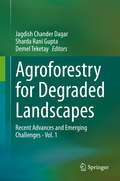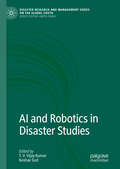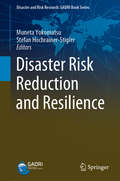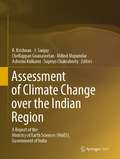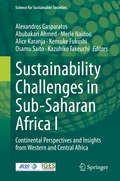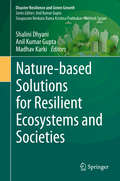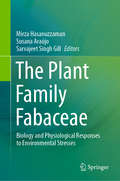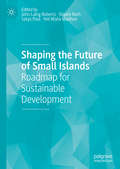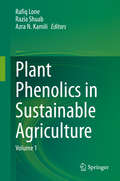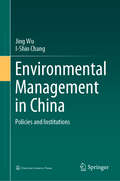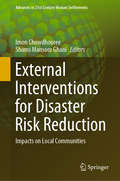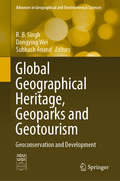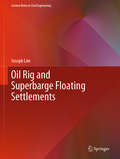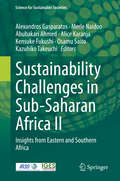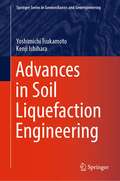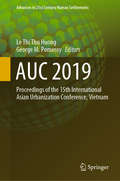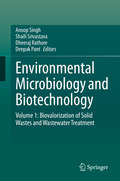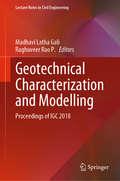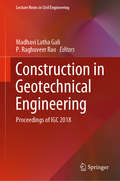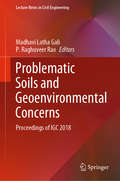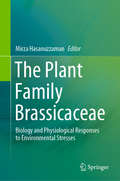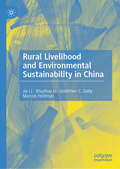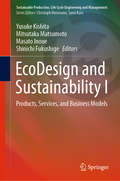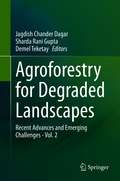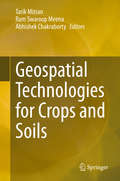- Table View
- List View
Agroforestry for Degraded Landscapes: Recent Advances and Emerging Challenges - Vol.1
by Jagdish Chander Dagar Sharda Rani Gupta Demel TeketayThis book presents various aspects of agroforestry research and development, as well as the latest trends in degraded landscape management. Over the last four decades, agroforestry research (particularly on degraded landscapes) has evolved into an essential problem-solving science, e.g. in terms of sustaining agricultural productivity, improving soil health and biodiversity, enhancing ecosystem services, supporting carbon sequestration and mitigating climate change. This book examines temperate and tropical agroforestry systems around the world, focusing on traditional and modern practices and technologies used to rehabilitate degraded lands. It covers the latest research advances, trends and challenges in the utilization and reclamation of degraded lands, e.g. urban and peri-urban agroforestry, reclamation of degraded landscapes, tree-based multi-enterprise agriculture, domestication of high-value halophytes, afforestation of coastal areas, preserving mangroves and much more. Given its scope, the book offers a valuable asset for a broad range of stakeholders including farmers, scientists, researchers, educators, students, development/extension agents, environmentalists, policy/decision makers, and government and non-government organizations.
AI and Robotics in Disaster Studies (Disaster Research and Management Series on the Global South)
by T. V. Vijay Kumar Keshav SudThis book promotes a meaningful and appropriate dialogue and cross-disciplinary partnerships on Artificial Intelligence (AI) in governance and disaster management. The frequency and the cost of losses and damages due to disasters are rising every year. From wildfires to tsunamis, drought to hurricanes, floods to landslides combined with chemical, nuclear and biological disasters of epidemic proportions has increased human vulnerability and ecosystem sustainability. Life is not as it used to be and governance to manage disasters cannot be a business as usual. The quantum and proportion of responsibilities with the emergency services has increased many times to strain them beyond their human capacities. Its time that the struggling disaster management services get supported and facilitated by new technology of combining Artificial Intelligence (AI) and Machine Learning (ML) with Data Analytics Technologies (DAT)to serve people and government in disaster management. AI and ML have advanced to a state where they could be utilized for many operations in disaster risk reduction. Even though many disasters cannot be prevented and a number of them are blind natural disasters yet through an appropriate application of AI and ML quick predictions, vulnerability identification and classification of relief and rescue operations could be achieved.
Disaster Risk Reduction and Resilience (Disaster and Risk Research: GADRI Book Series)
by Muneta Yokomatsu Stefan Hochrainer-StiglerThis book provides insight on how disaster risk management can increase the resilience of society to various natural hazards. The multi-dimensionality of resilience and the various different perspectives in regards to disaster risk reduction are taken explicitly into account by providing studies and approaches on different scales and ranging from natural science based methods to social science frameworks. For all chapters, special emphasis is placed on implementation aspects and specifically in regards to the targets and priorities for action laid out in the Sendai Framework for Disaster Risk Reduction. The chapters provide also a starting point for interested readers on specific issues of resilience and therefore include extensive reference material and important future directions for research.
Assessment of Climate Change over the Indian Region: A Report of the Ministry of Earth Sciences (MoES), Government of India
by R. Krishnan J. Sanjay Chellappan Gnanaseelan Milind Mujumdar Ashwini Kulkarni Supriyo ChakrabortyThis open access book discusses the impact of human-induced global climate change on the regional climate and monsoons of the Indian subcontinent, adjoining Indian Ocean and the Himalayas. It documents the regional climate change projections based on the climate models used in the IPCC Fifth Assessment Report (AR5) and climate change modeling studies using the IITM Earth System Model (ESM) and CORDEX South Asia datasets. The IPCC assessment reports, published every 6–7 years, constitute important reference materials for major policy decisions on climate change, adaptation, and mitigation. While the IPCC assessment reports largely provide a global perspective on climate change, the focus on regional climate change aspects is considerably limited. The effects of climate change over the Indian subcontinent involve complex physical processes on different space and time scales, especially given that the mean climate of this region is generally shaped by the Indian monsoon and the unique high-elevation geographical features such as the Himalayas, the Western Ghats, the Tibetan Plateau and the adjoining Indian Ocean, Arabian Sea, and Bay of Bengal. This book also presents policy relevant information based on robust scientific analysis and assessments of the observed and projected future climate change over the Indian region.
Sustainability Challenges in Sub-Saharan Africa I: Continental Perspectives and Insights from Western and Central Africa (Science for Sustainable Societies)
by Alexandros Gasparatos Abubakari Ahmed Merle Naidoo Alice Karanja Kensuke Fukushi Osamu Saito Kazuhiko TakeuchiThe aim of this 2-volume book is to highlight how Sustainability Science approaches can help solve some of the pervasive challenges that Africa faces. The volumes collect a number of local case studies throughout Africa that adopt transdisciplinary and problem-oriented research approaches using methodologies from the natural and the social sciences. These are put into perspective with chapters that introduce key sustainability challenges such using a regional focus. Through this multi-scale and inter/transdisciplinary approach the proposed volume will provide an authoritative source that will pack in a single volume a large amount of information on how Sustainability Science approaches sustainability challenges in African contexts. While there have been general books about sustainability science, none has had a strong African focus. As a result the 2-volume set fills a major gap in the Sustainability Science scholarship. This volume sets the stage for the series. Part I introduces key sustainability challenges in Africa. Parts II‐III highlights specific case studies related to these challenges from West and Central Africa.
Nature-based Solutions for Resilient Ecosystems and Societies (Disaster Resilience and Green Growth)
by Shalini Dhyani Anil Kumar Gupta Madhav KarkiOver the past few decades, the frequency and severity of natural and human-induced disasters have increased across Asia. These disasters lead to substantial loss of life, livelihoods and community assets, which not only threatens the pace of socio-economic development, but also undo hard-earned gains. Extreme events and disasters such as floods, droughts, heat, fire, cyclones and tidal surges are known to be exacerbated by environmental changes including climate change, land-use changes and natural resource degradation. Increasing climate variability and multi-dimensional vulnerabilities have severely affected the social, ecological and economic capacities of the people in the region who are, economically speaking, those with the least capacity to adapt. Climatic and other environmental hazards and anthropogenic risks, coupled with weak and wavering capacities, severely impact the ecosystems and Nature’s Contributions to People (NCP) and, thereby, to human well-being. Long-term resilience building through disaster risk reduction and integrated adaptive climate planning, therefore, has become a key priority for scientists and policymakers alike. Nature-based Solutions (NbS) is a cost-effective approach that utilizes ecosystem and biodiversity services for disaster risk reduction and climate change adaptation, while also providing a range of co-benefits like sustainable livelihoods and food, water and energy security. This book discusses the concept of Nature-based Solutions (NbS) – both as a science and as art – and elaborates on how it can be applied to develop healthy and resilient ecosystems locally, nationally, regionally and globally. The book covers illustrative methods and tools adopted for applying NbS in different countries. The authors discuss NbS applications and challenges, research trends and future insights that have wider regional and global relevance. The aspects covered include: landscape restoration, ecosystem-based adaptation, ecosystem-based disaster risk reduction, ecological restoration, ecosystem-based protected areas management, green infrastructure development, nature-friendly infrastructure development in various ecosystem types, agro-climatic zones and watersheds. The book offers insights into understanding the sustainable development goals (SDGs) at the grass roots level and can help indigenous and local communities harness ecosystem services to help achieve them. It offers a unique, essential resource for researchers, students, corporations, administrators and policymakers working in the fields of the environment, geography, development, policy planning, the natural sciences, life sciences, agriculture, health, climate change and disaster studies.
The Plant Family Fabaceae: Biology and Physiological Responses to Environmental Stresses
by Mirza Hasanuzzaman Susana Araújo Sarvajeet Singh GillThis book comprehensively introduces all aspects of the physiology, stress responses and tolerance to abiotic stresses of the Fabaceae plants. Different plant families have been providing food, fodder, fuel, medicine and other basic needs for the human and animal since the ancient time. Among the plant families Fabaceae have special importance for their agri-horticultural importance and multifarious uses apart from the basic needs. Interest in the response of Fabaceae plants toward abiotic stresses is growing considering the economic importance and the special adaptive mechanisms. Recent advances and developments in molecular and biotechnological tools has contributed to ease and wider this mission. This book provides up-to-date findings that will be of greater use for the students and researchers, particularly Plant Physiologists, Environmental Scientists, Biotechnologists, Botanists, Food Scientists and Agronomists, to get the information on the recent advances on this plant family in regard to physiology and stress tolerance.
Shaping the Future of Small Islands: Roadmap for Sustainable Development
by Shyam Nath John Laing Roberts Satya Paul Yeti Nisha MadhooThe book provides fresh look at the issues of sustainable development, degradation of natural resources and vulnerability to climate change in Small Island developing states (SIDS). It documents the deteriorating state of SIDS and adaptation efforts made to address the impending crisis of unsustainable economic growth with international, national and community support. Authors have discussed issues like macroeconomic trends, vulnerability, resilience capability, and SIDS-specific strategies focusing on sectors like trade and tourism. Discussion continues with the examination of democracy, social capital, quality of life, and health concerns. Climate change and natural resource challenges are analyzed using case studies. The book also discusses diplomatic complexities of international climate agreements, collective action and institutional quality constitute the analysis of global environment and sustainable development.
Plant Phenolics in Sustainable Agriculture: Volume 1
by Rafiq Lone Razia Shuab Azra N. KamiliThis book presents the latest research on plant phenolics, offering readers a detailed, yet comprehensive account of their role in sustainable agriculture. It covers a diverse range of topics, including extraction processes; the role of plant phenolics in growth and development; plant physiology; post-harvesting technologies; food preservation; environmental, biotic and abiotic stress; as well as nutrition and health. Further the book provides readers with an up-to-date review of this dynamic field and sets the direction for future research. Based on the authors’ extensive experience and written in an engaging style, this highly readable book will appeal to scholars from various disciplines. Bringing together work from leading international researchers, it is also a valuable reference resource for academics, researchers, students and teachers wanting to gain insights into the role of plant phenolics in sustainable agriculture.
Environmental Management in China: Policies and Institutions
by Jing Wu I-Shin ChangThis book details various stages in the introduction, establishment and evolution of China’s environmental management system. By combining a literature review, comparative analysis, and case study, it investigates the environmental management system in several key periods in order to systematically assess the necessary measures and appropriate adjustments the Chinese Government implemented to reconcile the growing conflicts between economic development and resources conservation, in the context of rapid economic growth and economic transformation. Given its scope, the book offers a valuable resource for experts, scholars, and government officials in related fields.
External Interventions for Disaster Risk Reduction: Impacts on Local Communities (Advances in 21st Century Human Settlements)
by Imon Chowdhooree Shams Mansoor GhaniThis book presents a case study-based analysis of the consequences of external interventions, critically evaluating them from community perspectives. Communities – from rural to urban, and around the world – that are experiencing disasters and changes in climatic variables can perceive the associated risks and evaluate the impacts of interventions. Accordingly, community perspectives, including their perceptions, concerns, awareness, realizations, reactions and expectations, represent a valuable resource. The case-based analysis of impacts on communities can provide a ‘means of learning’ from the experiences of others, thus expanding professionals’ knowledge base, especially regarding disaster mitigation and climate change adaptation practices in varied settings. This book offers valuable insights and lessons learned, in an effort to promote and guide innovative changes in the current planning, management and governance of human settlements, helping them face the future challenges of a changing environment.
Global Geographical Heritage, Geoparks and Geotourism: Geoconservation and Development (Advances in Geographical and Environmental Sciences)
by R. B. Singh Dongying Wei Subhash AnandThis book explores the geographical, geomorphological, ecological, touristic and socioeconomic aspects of natural heritage, argues for the dynamic conservation of that heritage and explains its key characteristics, promotion, conservation and management to achieve sustainable development goals. Emerging concepts such as geodiversity, geographical heritage sites, geomonuments, geoparks and geotourism are increasingly being used by conservationists. At present, the development of geoparks is a major global theme involving the application of geosciences to promote the inclusive growth of society and the protection and conservation of our unique geoheritage. Currently, there are 147 UNESCO global geoparks across 41 countries, in addition to a number of national-level geoparks. Pursuing a holistic approach towards such sites will sensitise the general public to the need for geoconservation of significant geosites and promote it through geotourism. It is a crucial issue, as various countries around the world are eager to develop their geoparks and are working for the conservation of geoheritage sites at the national level. This unique book gathers contributions from 15 countries in the form of case studies analysing the realities on of geographical heritage, geoparks and geotourism. The respective chapters address the role of geoparks as essential tools for education, recreation and nature conservation. Given its scope, the book offers a valuable guide for geoscientists, planners, policymakers, civil society and anyone concerned about the conservation of geoheritage sites and geoparks for a sustainable future Earth.
Oil Rig and Superbarge Floating Settlements (Lecture Notes in Civil Engineering #82)
by Joseph LimThis book presents a collection of proposed offshore and nearshore settlements in response to the emerging consequences of climate change. These settlements are counterpoints to megacities with unsustainable ecological footprints. The continuing depletion of natural resources has resulted in displaced communities, prompting the following research questions: What if we floated on sea instead of inefficiently consuming land? Could we use wave energy instead of nuclear energy? How can we replenish food supply and regenerate marine eco-diversity? How would our lives be shaped by new offshore settlements? What would we use as structures for shelter, farming, scaffolding and recreation? Floating cities emerged in the 1960s with Buckminster Fuller’s Triton City and Kenzo Tange’s Tokyo Bay Plan, and current manifestations include Vincent Callebaut’s Lilypad, the Seasteading Institute and the mile-long Freedom Ship housing 50,000 people. As an alternative to these examples, the book proposes the repurposing of three types of marine vessel: jack-up platforms, semi-submersibles and superbarges as sustainable, habitable structures to accommodate 20% of the projected 8.1 billion global population in 2025. The spatially conceived floating settlements include food and energy supplies for housing, recreation, education at sea, post-disaster health care and resettlement for nearshore deployment.
Sustainability Challenges in Sub-Saharan Africa II: Insights from Eastern and Southern Africa (Science for Sustainable Societies)
by Alexandros Gasparatos Merle Naidoo Abubakari Ahmed Alice Karanja Kensuke Fukushi Osamu Saito Kazuhiko TakeuchiThe aim of this two-volume book series is to highlight some of the most pervasive sustainability challenges that Sub-Saharan Africa faces. The two volumes contain 20 chapters that illustrate very diverse sustainability challenges throughout the continent, adopting interdisciplinary and problem-oriented research approaches, and methods from the natural and the social sciences. The very diverse case study chapters are put into perspective with chapters that introduce key sustainability challenges using a regional focus. Through this multi-scale and interdisciplinary approach the two volumes provide an authoritative source about the major sustainability challenges in the continent, and how to mobilise such perspectives to develop appropriate solutions. The two volumes have a uniquely broad focus that fills a major gap in the emerging Sustainability Science scholarship. Parts I-II highlight specific case studies on major sustainability challenges from Eastern and Southern Africa. Part III synthesizes the main lessons learnt from the chapters in the two edited volumes.
Advances in Soil Liquefaction Engineering (Springer Series in Geomechanics and Geoengineering)
by Yoshimichi Tsukamoto Kenji IshiharaThis book describes recent developments in soil liquefaction engineering and introduces more appropriate procedures than the current ones to evaluate triggering and consequences of soil liquefaction during earthquakes. The topics therefore cover all aspects of soil behaviour following liquefaction during earthquakes. The contents start with new approaches and new findings on characterisation of liquefaction resistance and undrained shear strength of fully saturated, partially saturated, and unsaturated sand, which are fully based on laboratory tests. New approaches and findings are then described on the use of in situ sounding tests for characterising triggering and consequences of soil liquefaction, including post-liquefaction settlement, lateral spreading, and stability against flow slide. All the topics are accompanied by illustrative case history data from recent major earthquakes in Japan.
AUC 2019: Proceedings of the 15th International Asian Urbanization Conference, Vietnam (Advances in 21st Century Human Settlements)
by Le Thi Thu Huong George M. PomeroyThis book presents selected articles from the 15th International Asian Urbanization Conference, held in Ho Chi Minh City, Vietnam, on November 27-30, 2019. Bringing together researchers and professionals in the area of urban planning and development to better understand the growing need for sustainable urban life, it covers topics such as climate change and urban resilience; inclusive and implementable urban governance; smart and green mobility; transformations in land management; livable and smart cities; integrated planning and development; urban slums and affordable housing; sustainable urban finance; and urban renewal and redevelopment.
Environmental Microbiology and Biotechnology: Volume 1: Biovalorization of Solid Wastes and Wastewater Treatment
by Anoop Singh Shaili Srivastava Dheeraj Rathore Deepak PantThis book provides up-to-date information on the state of the art in applications of biotechnological and microbiological tools for protecting the environment. Written by leading international experts, it discusses potential applications of biotechnological and microbiological techniques in solid waste management, wastewater treatment, agriculture, energy and environmental health. This first volume of the book “Environmental Microbiology and Biotechnology,” covers three main topics: Solid waste management, Agriculture utilization and Water treatment technology, exploring the latest developments from around the globe regarding applications of biotechnology and microbiology for converting wastes into valuable products and at the same time reducing the environmental pollution resulting from disposal. Wherever possible it also includes real-world examples. Further, it offers advice on which procedures should be followed to achieve satisfactory results, and provides insights that will promote the transition to the sustainable utilization of various waste products.
Geotechnical Characterization and Modelling: Proceedings of IGC 2018 (Lecture Notes in Civil Engineering #85)
by Madhavi Latha Gali Raghuveer Rao P.This volume comprises select papers presented during the Indian Geotechnical Conference 2018, discussing issues and challenges relating to the characterization of geomaterials, modelling approaches, and geotechnical engineering education. With a combination of field studies, laboratory experiments and modelling approaches, the chapters in this volume address some of the most widely investigated geotechnical engineering topics. This volume will be of interest to researchers and practitioners alike.
Construction in Geotechnical Engineering: Proceedings of IGC 2018 (Lecture Notes in Civil Engineering #84)
by Madhavi Latha Gali P. Raghuveer RaoThis volume comprises select papers presented during the Indian Geotechnical Conference 2018. This volume discusses construction challenges and issues in geotechnical engineering. The contents cover foundation design and analysis, issues related to geotechnical structures, including dams, retaining walls, embankments and pavements, and rock mechanics and construction in rocks and rocky environments. Many of the papers discuss live case studies related to important geotechnical engineering projects worldwide, providing useful insights into the realistic designs and constructions. This volume will be of interest to students, researchers and practitioners alike.
Problematic Soils and Geoenvironmental Concerns: Proceedings of IGC 2018 (Lecture Notes in Civil Engineering #88)
by Madhavi Latha Gali P. Raghuveer RaoThis volume comprises select papers presented during the Indian Geotechnical Conference 2018. This volume focuses on discussing the many challenges encountered in geoenvironmental engineering. The book covers sustainability aspects related to geotechnical engineering, problematic soils and ground improvement, use of geosynthetics and concepts of soil dynamics. The contents of this book will be useful to researchers and professionals working in geo-environmental engineering and to policy makers interested in understanding geotechnical concerns related to sustainable development.
The Plant Family Brassicaceae: Biology and Physiological Responses to Environmental Stresses
by Mirza HasanuzzamanThis book provides all aspects of the physiology, stress responses and tolerance to abiotic stresses of the Brassicaceae plants. Different plant families have been providing food, fodder, fuel, medicine and other basic needs for the human and animal since the ancient time. Among the plant families, Brassicaceae has special importance for their agri-horticultural importance and multifarious uses apart from the basic needs. Interest understanding the response of Brassicaceae plants toward abiotic stresses is growing considering the economic importance and the special adaptive mechanisms. The knowledge needs to be translated into improved elite lines that can contribute to achieve food security. The physiological and molecular mechanisms acting on Brassicaceae introduced in this book are useful to students and researchers working on biology, physiology, environmental interactions and biotechnology of Brassicaceae plants.
Rural Livelihood and Environmental Sustainability in China (China Connections Ser.)
by Jie Li Shuzhuo Li Gretchen C. Daily Marcus FeldmanThe book considers the challenge of poverty and deterioration of the ecological environment in China, particularly in rural areas. Examining key factors such as the overuse of natural resources and the loss of biodiversity in the face of an expanding population and rapidly developing economy. It focuses on examining the frameworks of rural households in poor mountainous areas in rural China, considering their livelihood choices and decision-making processes. It analyses the relationship between these households’ livelihoods and their environment, notably farmers’ attitudes and perceptions towards ecological conservation policies, and their use of forest resources. Cutting across the fields of population studies, sociology, economy and environment, this is an important read for scholars and students interested in how China is dealing with the challenges of natural resources exploitation, sustainable development and social welfare.
EcoDesign and Sustainability I: Products, Services, and Business Models (Sustainable Production, Life Cycle Engineering and Management)
by Yusuke Kishita Mitsutaka Matsumoto Masato Inoue Shinichi FukushigeThis book highlights cutting-edge ecodesign research, covering product and service design, smart manufacturing, and social perspectives in ecodesign. Featuring selected papers presented at EcoDesign 2019: 11th International Symposium on Environmentally Conscious Design and Inverse Manufacturing, it also includes diverse, interdisciplinary approaches to foster ecodesign research and activities. In the context of Sustainable Development Goals (SDGs), it addresses the need for the manufacturing industry to design innovations for sustainable value creation, taking into account technological developments, legislation, and consumer lifestyles. Further, the book discusses the concept of circular economy, which originated in Europe and aims to increase resource efficiency by shifting away from the linear economy. Focusing on product life cycle design and management, smart manufacturing, circular economy, and business strategies, and providing useful approaches and solutions to these emerging concepts, this book is intended for both researchers and practitioners working in the broad field of ecodesign and sustainability.
Agroforestry for Degraded Landscapes: Recent Advances and Emerging Challenges - Vol. 2
by Jagdish Chander Dagar Sharda Rani Gupta Demel TeketayThis book presents various aspects of agroforestry research and development, as well as the latest trends in degraded landscape management. Over the last four decades, agroforestry research (particularly on degraded landscapes) has evolved into an essential problem-solving science, e.g. in terms of sustaining agricultural productivity, improving soil health and biodiversity, enhancing ecosystem services, supporting carbon sequestration and mitigating climate change. This book examines temperate and tropical agroforestry systems around the world, focusing on traditional and modern practices and technologies used to rehabilitate degraded lands. It covers the latest research advances, trends and challenges in the utilization and reclamation of degraded lands, e.g. urban and peri-urban agroforestry, reclamation of degraded landscapes, tree-based multi-enterprise agriculture, domestication of high-value halophytes, afforestation of coastal areas, preserving mangroves and much more. Given its scope, the book offers a valuable asset for a broad range of stakeholders including farmers, scientists, researchers, educators, students, development/extension agents, environmentalists, policy/decision makers, and government and non-government organizations.
Geospatial Technologies for Crops and Soils
by Tarik Mitran Ram Swaroop Meena Abhishek ChakrabortyThe sustainable development of the agriculture sector is the only option to meet the demands of increased and economically viable production in a changing climate. This means there is a need to introduce the latest technologies to enhance production, and also help policymakers make decisions for the future. Geospatial technologies & tools, such as remote sensing, geographical information systems (GIS), global positioning systems (GPS), and mobile & web applications, provide unique capabilities to analyze multi-scale, multi-temporal datasets, and support decision-making in sustainable agriculture development and natural resources management. Further, the availability of reliable and timely geospatial information on natural resources and environmental conditions is essential for sustainable agricultural development and food security. Since remote sensing solutions are fast, non-destructive and have large spatial coverage, they can play a significant role in the identification, inventory, and mapping of land resources. Over the past four decades, remote sensing has proved to be a cost-effective and powerful tool to assess crop and soil properties in varying spatial and temporal scales using both visual and digital techniques. Satellite remote sensing coupled with GIS & mobile-app based positional information has emerged as an efficient tool for optimizing input resources, and minimizing cost of production and risk of biotic/ abiotic factors nature to promote sustainable agriculture. This book comprehensively documents the applications of space-based technologies for crop and soil assessments for the sustainable development of agriculture.
